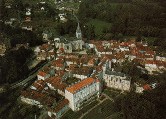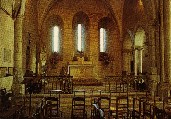Château L'Evèque

Vincent de Paul's Ordination
Vincent de Paul was ordained a priest on September 23, 1600, in a chapel at Château L'Evèque, a village in the south of France. There is a certain amount of controversy surrounding this date, as it would mean he was only 19 years of age at the time, making him below the required canonical age for priesthood ordination. It seems the reforms of the Council of Trent had not yet reached this corner of France. Further discussion centres around the reasons for Vincent going to Château L'Evèque, in the hills of the Dordogne, and some distance from Toulouse where he was then residing, for his ordination.
The picture at top right of this page shows an aerial view of the village of Château L'Evèque. The picture on the left of the page shows the interior of the Chapel where Vincent was ordained. A plaque on the left wall commemorates his ordination. This Chapel is now forms part of the transept in the present day Church.
As its name indicates, the town of Château-l'Évêque is called after the fortress and the residence of the bishops of Périgueux, ten kilometers to the south. It has borne this name officially, however, only since 1831. The bishops used this fort-residence from the fourteenth century to the Revolution. Its importance came from its location at a significant point in the Beauronne valley water system. The chateau underwent major reparis in the fifteenth and sixteenth centuries. In the sixteenth century, Protestant (Huguenot) forces often attacked it. In fact they succeeded in assassinating the bishop of Périgueux in 1575. Now in private hands, its recent owners have named the castle Château Saint Vincent.
Next to the chateau is the parish church of Saint Julian. Since the name Julian, a patron of sick travelers, was often attached to hospices for travelers, it can be presumed that this chapel was originally used for pilgrims and travelers. It has since been incorporated as a side chapel in the small parish church. It keeps its original orientation, facing away from the present main altar.
Thanks to the efforts of Father Jean Baptiste Etienne, the parish church was restored beginning in 1874. The windows (dated 1887) in the nave present original themes from Vincent's life. The first two depcit "Saint Vincent de Paul in Landes," and "The family of Saint Vincent de Paul." The second set shows the "Entry of Saint Vincent de Paul in Château l'Évêque," and "Saint Vincent de Paul at Bauzet," where he had a small school. These windows, however, depict the Berceau as it was in the nineteenth century, full of young pine trees. In Vincent's time it was less wooded. Another large window in the side chapel compares the life of Vincent with that of Joseph: the death of Joseph and the death of Vincent; Jesus at work with Joseph, and Vincent helping a poor man and holding an infant; the marriage of Mary and Joseph, and the ordination of Vincent. A small altar has some reliefs portraying his ordination, teaching and first Mass. A plaque recalls his ordination there, as do copies in Latin and French of his ordination document.
The remains of the early chapel consist principally of the two pilasters at the edge of the sanctuary (the three double Gothic columns are nineteenth century) and the stones in the floor of the sanctuary. Above the sanctuary was an attic, an area now demolished. It was there among old papers that a copy of the saint's ordination record was found in the nineteenth century.
Several questions have arisen concerning Vincent's priestly ordination. Why did he obtain written permission (dimissorial letters) from the diocese of Dax but not use the permission for more than a year? Also, why was he ordained by François de Bourdeille, the bishop of Périgueux, and not by his own bishop of Dax, to whose diocese he belonged until the foundation of the Congreation of the Mission? No one knows the answer to these questions. Vincent's delay may reflect his hesitation to submit to ordination in a diocese whose relatively new bishop, Jacques Du Sault (1570-1623), was something of a reformer. The young bishop would probably have had some difficulty in ordaining a man who was nineteen or twenty years old (even though Vincent's dimissorial letter repeated the standard formula that he was of "legitimate age"), and who would not finish his theological studies for another four years. Since his bishop had been chaplain for Queen Marguerite de Valois in Paris, he may have had a hand in nominating his young priest, Father DePaul, to the same position. This may show that the bishop had no problem with him. In any case, François de Bourdeille was not a bad bishop. He had been active in reorganizing his diocese, holding synods, etc. He died 24 October 1600).
Another possibility is that Bishop de Bourdeille had helped Vincent financially in his studies and he, in return, helped to educate Boudeille's nephews at his school in Buzet. This, at least, was the tradition among the bishop's relatives, recounted as late as the mid-nineteenth century.
Why was Vincent ordained here and not in Saint Étienne cathedral in Périgueux? First, the Huguenots still held power in Périgueux and it would have been difficult for the elderly bishop to travel. Second, in any case, the bishop no longer lived in Péreigueux (since his residence had been destroyed) and he had no usable cathedral (since the Protestants had partially demolished it).
Where exactly was he ordained? The bishop called the oratory his "church" in the official ordination document. This leads to the conclusion that he did not ordain Vincent secretly or privately in his domestic chapel, as some have suggested, but in the oratory on the public road by his castle.
When he was ordained is clearly reported in the ordination document, 23 September 1600. The same document also records that the date was Saturday of the Ember Week, one of the days stipulated for ordinations. This may explain the expression in the document "general ordinations," but it does not prove whether Vincent was ordained alone or together with others.
Château-l'Êvéque is a small village of 1,800 persons. The Daughters of Charity run a retirement home here (begun in 1869) and receive guests as lodgers for retreats, etc. Some Vincentians lived here from 1877 to 1883 and returned later as chaplains to the Sisters. During the Second World War, the body of Saint Vincent was hidden in their chapel (from 20 May 1940 to 3 June 1945). As the Nazis made some advances in 1942, the body was temporarily removed from there to a woodshed for fear of discovery.
At the south edge of town is a road leaing to Périgueux said to have been laid out in the time of the ancient Romans (Voie Romaine). To the left, before this road begins, are signs for the Calvaire, a modern series of Stations of the Cross leading up the hillside.
Many years later Vincent reflected on his priesthood: As for myself, if I had known what it was when I had the temerity to enter it --- as I have come to know since then --- I would have preferred to till the soil than to commit myself to such a formidable state of life. I have said this more than a hundred times to poor country people when, to encourage them to live contentedly as upright persons, I told them I considered them fortunate in their situation. Indeed, the older I get, the more convinced I am of this because day by day I discover how far removed I am from the state of perfection in which I should be living (letter 2027).
FURTHER RESOURCES
WEB LINK(S)

